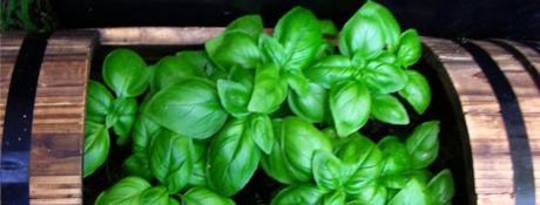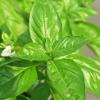
Sweet Basil -- Ocimum basilicum
Sweet basil, like so many of the aromatic herbs, is a member of the easily and widely cultivated Lamiaceae family of mints. You have only to crush it between your fingers to release the essence of its scent. The genus name, Ocimum, meaning “smell,” alludes to the sweet and aromatic odor of these plants.
Sweet Basil's History
Sweet basil is considered to have originated in India and Persia prior to being brought to Greece by Alexander the Great. If you were to travel throughout the region surrounding the Mediterranean Sea, you would find sweet basil growing extensively. In the late 1600s the colonists brought sweet basil to America, where it is still highly prized for its culinary and medicinal value.
The true botanical identity of sweet basil is questionable and of some scientific concern, because it has a tendency to be promiscuous and cross-pollinate. This has resulted in a large number of subspecies. Sweet basil is the most familiar, but the list of basil species and cultivars is extensive and exotic. The world of Ocimum basilicum brings us cultivars like ‘Cinnamon,’ ‘Thai,’ ‘Genovese,’ ‘Persian,’ ‘Spicy Globe,’ and ‘Dark Opal,’ to name a few. ‘Lemon Basil’ and ‘Lime Basil’ are Ocimum americanum cultivars. Another important species is holy basil, Ocimum sanctum, known in India as tulsi, where it is venerated by Hindus and a principal plant in Ayurvedic medicine. Tulsi is believed to be the “elixir of life” and thought to promote longevity.
Get The Latest By Email
Sweet Basil's Many Uses in the Kitchen
Sweet basil’s many herbal uses include culinary, landscaping, medicinal, and spiritual, and the essential oil can be found in fragrances and insect repellents. Cultivated largely as a culinary herb and often associated with Italian cuisine, basil is excellent in tomato-based dishes. It is also used cooked or raw in sauces, stews, salad dressings, vegetable and meat dishes, bean dishes, vinegars, confectionery products, and the liqueur Chartreuse.
 While sweet basil can be successfully dried, it is best used fresh in cooking, as the dried herb loses most of its flavor. The fresh herb smells of clove and tastes somewhat like anise. As the main ingredient in the original pesto, pesto alla genovese, a sauce originating in northern Italy, sweet basil is crushed along with garlic and combined with olive oil, coarse salt, and grated hard cheese. Now a popular dish throughout Europe and North America, pesto has evolved to include the addition of minced pine nuts or walnuts. While pesto is commonly used on pasta, it has also been traditionally added to potatoes and green beans.
While sweet basil can be successfully dried, it is best used fresh in cooking, as the dried herb loses most of its flavor. The fresh herb smells of clove and tastes somewhat like anise. As the main ingredient in the original pesto, pesto alla genovese, a sauce originating in northern Italy, sweet basil is crushed along with garlic and combined with olive oil, coarse salt, and grated hard cheese. Now a popular dish throughout Europe and North America, pesto has evolved to include the addition of minced pine nuts or walnuts. While pesto is commonly used on pasta, it has also been traditionally added to potatoes and green beans.
Basil is also an important spice in Thai, Laotian, and Vietnamese cooking. When added to food, it is warming and carminative, aiding in digestion. Sweet basil is an excellent source of vitamin K; a very good source of vitamin A, calcium, and iron; and a good source of vitamin C, magnesium, potassium, and manganese. It is best not overcooked.
Sweet Basil in the Landscape & Garden
As a landscaping herb, sweet basil is an annual whose flowers attract bees in the summer. It grows to approximately two feet in height, requires full sun and a light to sandy, well-drained soil, and should be planted in late spring and harvested in early fall. Companion planting sweet basil next to tomatoes can help ward off the white fly that plagues them. Sweet basil’s essential oil also acts as a larvicide against houseflies and mosquitoes, and the potted plant was frequently placed on windowsills and near doorways to keep the flies out.
Sweet Basil As Medicine
Traditionally sweet basil has been used to treat a vast array of ailments, from headaches and nausea to sinus congestion and fevers. Energetically, sweet basil is both warming and calming, and as a tea, it stimulates the lungs, calms the stomach, and dries internal dampness. It is widely used in aromatherapy due to its volatile oil. The steamed, distilled essential oil of sweet basil contains high amounts of camphor compounds, known to possess antibacterial and antifungal properties and useful against some strains of Staphylococcus and Candida.
A soap made from sweet basil essential oil not only smells pleasant, but also works well as an antibacterial soap and may be effective in treating acne. Sweet basil, like oregano, has been shown to have antioxidant activity, as well as antispasmodic and anti-inflammatory properties, and may prove useful in treating inflammatory bowel disease and arthritis.
Legends & Symbolism
The many rituals, beliefs, legends, and lore surrounding sweet basil have for centuries brought forth a mix of symbolism that includes the polar opposites of love and fear, danger and protection, life and death. But its strongest symbolism may be that of offering protection while invoking inner strength. To the Cherokee it is a “West Medicine” that focuses on the internal aspects of the physical body.
This article has been adapted from the book:
 Wisdom of the Plant Devas: Herbal Medicine for a New Earth
Wisdom of the Plant Devas: Herbal Medicine for a New Earth
by Thea Summer Deer.
Reprinted with permission of the publisher, Bear & Company, an imprint of Inner Traditions Inc. ©2011. www.innertraditions.com
Click here for more info or to order this book on Amazon.
 About the Author
About the Author
Thea Summer Deer is a clinical herbalist, singer-songwriter, midwife, and childbirth educator. As a child she learned how to shoot a bow, canoe, weave and gather medicinal herbs. Raised with the Seminole Indians in South Florida until the age of eight, she lives surrounded by Cherokee ancestral land in the Appalachian Mountains of western North Carolina. Visit her website at www.theasummerdeer.com







